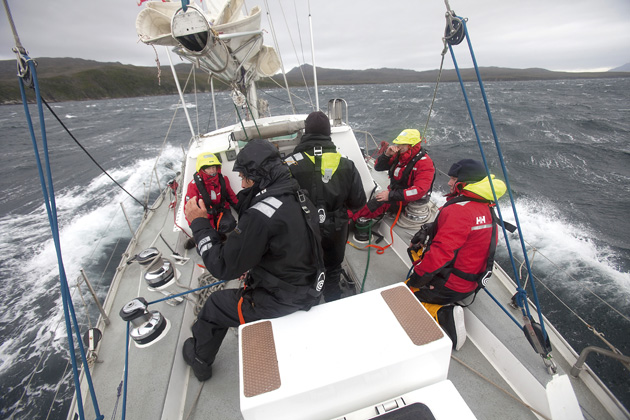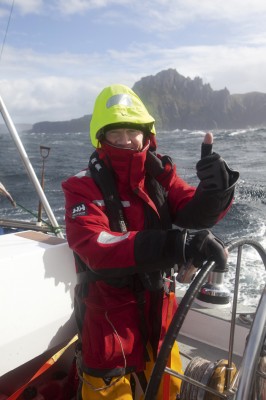Rounding Cape Horn
We were up at 0530 for our Cape Horn day, to release our lines and prepare the yacht for sea, a task which took more than two and a half hours. There was no rushing, just a methodical stowing of equipment, checking of heavy weather clothing, lifejackets and harnesses and a briefing about common sense and hanging on! A decent breakfast was essential.
As we nosed out into a steady 35 knots from the west there was a sense of foreboding as bullet-like williwaws buffeted us, the wind bouncing between Isla Hermite and Isla Chanticleer. With four reefs and the staysail, Pelagic seemed to take everything in her stride.
Before we were completely exposed to the 3,000-mile fetch of the Southern Ocean, we decided to undertake another of our seamanship tasks by hauling the staysail to weather, lashing the wheel and heaving to.
We allowed the yacht to find a comfortable angle not directly broadside on to the waves and not too close to the wind. She found it and we joggled along at a knot or two confident that we could go below and rest if we had the sea room. We eased the weather sheet and off we set for the Horn.
There are some common misconceptions about Cape Horn. First, it’s on a small island a long way from mainland Chile; second it’s not the most southerly point of South America – that goes to Islas Diego Ramirez, a group to the south-west – and third you only earn your earring if you sail from 50°S on one coast of South America to 50°S on the other, a distance of nearly 1,000 miles.
There are some common misconceptions about Cape Horn. First, it’s on a small island a long way from mainland Chile; second it’s not the most southerly point of South America
We were taking just a day, but what a day it turned out to be. As we emerged from the lee of the land the huge, long sea became apparent over our starboard quarter and a separate chop on top of the underlying wavetrain added to the confusion. Now Pelagic began to feel small. She was thrown around more readily, but was never out of control. It was exhilarating stuff as we swept east under our tiny sail-plan swinging wildly against the dark outline of the Horn.
As we closed the headland, two large off-lying rocks were clearly visible mainly because spray was being thrown vertically at least 200ft as the rollers hit them. Visibility was good at this stage so we were able to close to within a few hundred metres and as the Horn came abeam the sun shone as if to celebrate with us.
But within minutes, under cloud scudding in from the south, the wind rose sharply to 55 knots, driving rain and spume reduced visibility to a few metres, completely blotting out the Horn. For ten minutes Pelagic took the strain, was heaved about and on one wave was knocked well down, forcing water over our high cockpit coaming.
Heading for shelter
The squall was over as quickly as it had arrived and as we bore away with the wind back down to about 40 knots, the sun burst through, Peale’s dolphins leapt out of the face of following waves and played under our bows as we headed for shelter in the lee of Hornos itself.
Our one regret was that, owing to the conditions, we were unable to land on Isla Hornos where you can walk to the lighthouse, talk with the keepers and have your passport stamped to prove you’ve been there.
Instead we decided to retrace our steps all the way to Puerto Toro and then back to Puerto Williams where we had a date with the local yacht club. En route we were able to complete our remaining heavy weather exercises, including reefing techniques.
We just missed the 1800 check-in deadline at Puerto Williams, but this did not prevent us from visiting Micalvi, the name of a 1925 German freighter built originally for the river Rhine, which somehow found its way to becoming the headquarters for what is claimed to be the most southerly yacht club in the world.
Yachts moor in ever-increasing lines abreast to the Micalvi and in the evening crews gather in the club, having enjoyed the deliciously hot and plentiful club showers. The party gets going in the low-ceilinged bar or, in wonderful contravention of popular political correctness, on the hardwood panelled bridgedeck where smoking is allowed and the club’s famed pisco sours are consumed in alarming quantities.
Commodore Alejandro ‘Alex’ Reyes Nettle will enthusiastically fill you in on imminent development plans – we hope they don’t spoil it – and the Yachting World team were honoured by being presented with Micalvi YC burgees.
Appropriately, the weather had the final say as Puerto Williams was again closed owing to strong winds, preventing our return to Ushuaia in time for our flights to the UK. We were forced to make our farewells to Pelagic here and take an hour-long minibus ride west along the north coast of Isla Navarino before taking a RIB-style high-speed ferry to Ushuaia.
As we sped across the Beagle Channel, I could just make out some of the glaciers which run down to its northern shore and made a mental note that if we ever came here again I’d turn west instead of east out of Ushuaia.
But for now we’d completed our heavy weather research and for once the rigours of winter back in the UK seemed appealing.
Skip Novak’s Storm Sailing Techniques series
Part 1: Skip explains the ‘Pelagic philosophy’
Part 3: Skip’s view on storm sails
Part 6: preparing the deck for heavy weather
Part 7: Skip’s view on sail design
Part 8: using drogues and sea anchors
Part 9: sounding an uncharted bay ready for anchoring
Part 10: anchoring in heavy weather
Part 11: tying to shore using long lines
Part 12: dinghy handling in heavy weather
12-part series in association with Pantaenius







